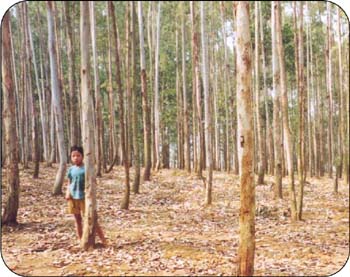In other cases, however, the "failures" have been caused by a more complex array of factors. In many of these cases, the notion of "success" or "failure" is less clear-cut.
Sometimes, these failures have involved plantations being established without a clear idea of the possible markets for the goods they might produce. In such cases, logs may end up being sold for firewood rather than for producing sawn timber, for example.
|
Some 40 to 50 percent of plantations in the Asia-Pacific have been established by clearing natural forests, rather than by using degraded or abandoned lands |
|
Box 3. Reforestation success on a large scale - - the Korean experience The Korean experience with reforestation demonstrates "success" on a large scale. In the 1950s, Korea had large areas of degraded land without forest cover. Reforestation started in 1959, and expanded over time through a series of National Forest Development Plans. The first of these plans was undertaken between 1973 and1978 when one million ha were reforested. A series of subsequent plans followed which have led to an area of over four million ha being reforested in total. The land used for reforestation had belonged to a variety of landowners including national and provincial governments, industrial companies and private landowners. The objective and focus of the reforestation programme has changed over time as various targets were achieved. Likewise, the species used have also changed. The early plantations, for example, were largely established to provide fuelwood for small farmers and used fast-growing species such as Larix kaempferi, Pinus rigida and Populus species. Subsequently, as more industrial plantations were established, different species were used that were more suited for various commercial end-uses. More recently, reforestation has also been undertaken for protection and conservation reasons, and not just timber production. At present around 78 species, including many native species, are being planted and the whole process is becoming less dependent on government resources and direction. After the fourth Forest Development Plan ends in 2007, the government's role will diminish and be taken over by the private sector. |
In other cases, the supposed market may have declined during the time it took for the trees to mature. This might occur as a result of oversupply of timber caused when many plantations mature at the same time. Plantation owners may lose out in these circumstances, but many local people may have still have benefited from the employment created by these plantations.
However, the fundamental problem with many past reforestation programmes has been that the reforestation effort has been too one-dimensional - the plantation was managed to meet a very limited set of objectives.
Most plantation managers, for example, have simply sought to provide a single product (e.g. large volumes of cheap, low-grade timber) and have not been concerned about also providing ecological services. These managers might argue that it was not their responsibility to do so, but others, believing themselves to be legitimate stakeholders, have argued otherwise.
Many plantations have also used short rotations, which mean they have run the risk of generating significant environmental problems such as erosion and nutrient depletion unless they have been carefully managed.

Litter and small twigs regularly harvested and used for fuel... no understorey develops and erosion is more likely at this site, leading to nutrient deficiencies that slow tree growth.
Of course, there is nothing intrinsically wrong with such single-purpose plantations. Indeed, many owners would regard these as very successful. What critics of these plantations argue, however, is that nearly all large reforestation projects have been of this kind. This means that this form of reforestation helps provide some of the goods but few of the services once provided to rural communities by the original forests.
This last problem has been compounded by the fact that perhaps some 40 to 50 percent of plantations in the Asia-Pacific region have also been established by clearing natural forests, rather than by using degraded grasslands or abandoned farmland (Hurst 1990, FAO 2001).